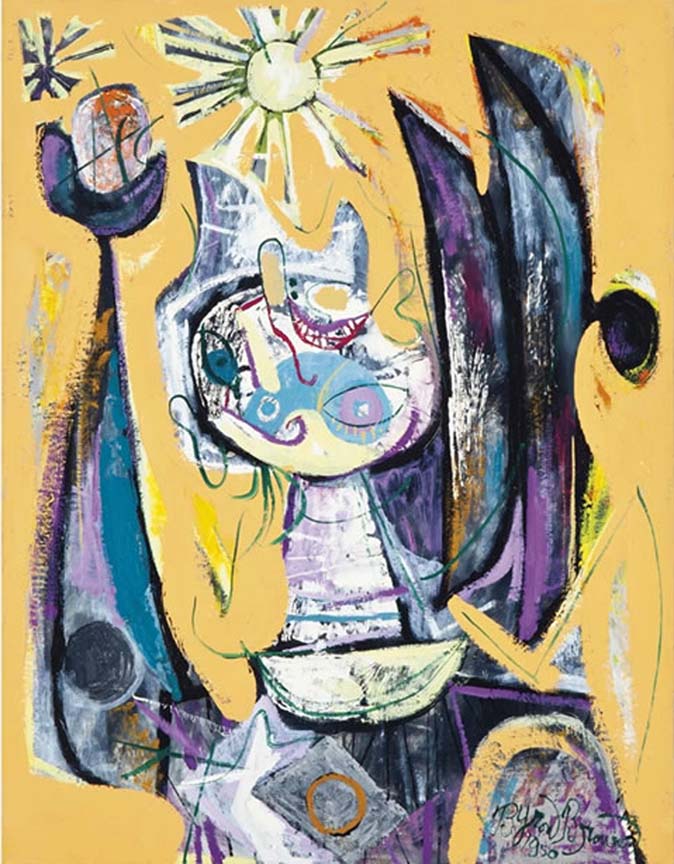Byron Browne
1907-1961
Byron Browne's artistic training was conventional, and little about his career at the National Academy of Design from 1924-1928 suggested that he would soon depart from the traditional methods in which he was being schooled. Several experiences are identified as being formative for Browne's career as an abstract artist. In 1927 he and his friend Arshile Gorky visited Albert E. Gallatin's Gallery of Living Art, where they saw works of Picasso, Braque and Miró. Stimulated by what he saw there, Browne began to study Cahiers d'Art, the French magazine devoted to progressive European art. As he experimented with Cubism, Browne's conviction that abstraction represented the future of art grew. His complete break from traditional art is perhaps best expressed in his decision to destroy his early representational work.
By 1930 the direction of Browne's work was clearly established. By the mid 1930s, he found work and support within the Works Progress Administration Mural Division, as Burgoyne Diller, the Division's head, began to advocate and organize in behalf of abstract artists. Browne became a founding member of the American Abstract Artists, as well as having involvement in a variety of other political and artistic groups at this time. Like his wife, the artist, Rosalind Bengelsdorf, Browne wrote and spoke frequently in defense of abstraction.
According to Byron Browne, the roots of abstraction could be found in the natural world, and as such, abstraction could not be separated from life itself. He saw abstraction as an extension of the physical world, rather than generated by spiritualism. The distinction was an important one to Browne, who had little tolerance for the mysticism that Hilla Rebay and others believed to be at the foundation of abstraction.
In the 1930s, Cubism can be seen as the dominant influence in his work, while by the 1940s his paintings had relaxed into softer, biomorphic forms reminiscent of Arp and Miró. In the 1950s, in response to the emergence of Abstract Expressionism, his work became more gestural and painterly. However, these styles were never mutually exclusive; Browne felt free to combine any or all of these elements, depending on his expressive intent.
In addition to his career as a painter, Browne was also a teacher. He taught at the Art Students League beginning in 1948, and in 1949 he became a professor of advanced painting at New York University. Byron Browne died in New York in 1961.
Excerpt taken from American Abstract Art of the 1930s and 1940s, The J. Donald Nichols Collection, Margaret Gregory. Harry N. Abrams, Inc. Publishers, New York. 1998
SELECTED MUSEUM COLLECTIONS
Ackland Art Museum, University of North Carolina, Chapel Hill, NC
Arkansas Arts Center, Little Rock, AK
The Art Museum, Princeton University, Princeton, NJ
Art Students League, New York, NY
Ball State University Art Gallery, Muncie, IN
Bell Gallery, List Art Center, Brown University, Providence, RI
Boca Raton Museum of Art, Boca Raton, FL
The Brooklyn Museum, Brooklyn, NY
The Butler Institute of American Art, Youngstown, OH
The Canton Art Institute, Canton, OH
The Chrysler Museum, Norfolk, VA
College Art Gallery, SUNY, New Paltz, NY
Columbia Museum of Arts and Sciences, Columbia, SC
Dallas Museum of Art, Dallas, TX
Denver Art Museum, Denver, CO
Everson Museum of Art of Syracuse and Onondaga County, New York, NY
Fogg Art Museum, Harvard University, Cambridge, MA
Herbert F. Johnson Museum of Art, Cornell University, Ithaca, NY
The High Museum of Art, Atlanta, GA
Hirshhorn Museum and Sculpture Garden, Washington, DC
Holbrook Collection, Georgia Museum of Art, University of Georgia, Athens, GA
Hudson River Museum of Westchester, Yonkers, NY
Indiana University Art Museum, Bloomington, IN
Iris and B. Gerald Cantor Center for Visual Arts, Stanford University, CA
James A. And Mari Michener Collection, University of Texas at Austin, Austin, TX
Jane Voorhees Zimmerli Art Museum, Rutgers University at New Brunswick, NJ
Joe and Emily Lowe Art Gallery, Syracuse University, Syracuse, NY
Kemper Museum of Contemporary Art, Kansas City, MO
Krannert Art Museum, University of Illinois, Champaign, IL
Long Beach Museum of Art, Long Beach, CA
Los Angeles County Museum of Art, Los Angeles, CA
Memorial Art Gallery of the University of Rochester, Rochester, NY
The Metropolitan Museum of Art, New York, NY
Milwaukee Art Center, Milwaukee, WI
Montgomery Museum of Fine Arts, Montgomery, AL
Munson-Williams-Proctor Institute Museum of Art, Utica, NY
Museum of Art, Carnegie Institute, Pittsburg, PA
Museum of Art, Tel Aviv, Isreal
Museum of Art, University of Oklahoma, Norman, OK
Museum of Fine Arts, Boston, MA
The Museum of Fine Arts, Houston, TX
The Museum of Modern Art, New York, NY
Museum of Modern Art, Rio de Janeiro
Philharmonic Center for the Arts, Naples Museum of Art, Naples, FL
Nassau County Museum of Fine Art, Roslyn, NY
National Museum of Fine Arts, Buenos Aires, Argentina
Neuberger Museum, Purchase College, Purchase, NY
New Jersey State Museum, Trenton, NJ
The Newark Museum, Newark, NJ
Orange County Art Museum, Newport Beach, CA
Pace University Art Collection, New York, NY
Parrish Art Museum, Southampton, NY
The Pennsylvania Academy of Fine Arts, Philadelphia, PA
The Philadelphia Museum of Art, Philadelphia, PA
Phoenix Art Musuem, Phoenix, AZ
Provincetown Art Association and Museum, MA
Rose Art Museum, Brandeis University, Waltham, MA
Roswell Museum and Art Center, Roswell, NM
Sao Paolo Museum of Modern Art, Brazil (gift of Nelson Rockefeller)
Smithsonian American Art Museum, Washington, DC
Staten Island Institute of Arts and Sciences, NY
Trisolini Gallery, Ohio University, Athens, OH
University Gallery, University of Minnesota, Minneapolis, MN
University of Arizona Museum of Art, Tucson, AZ
University of Iowa Museum of Art, Iowa City, IA
Walker Art Center, University of Minnesota, Minneapolis, MN
Weatherspoon Art Gallery, University of North Carolina, Greensborough, NC
Whitney Museum of American Art, New York, NY
Williams College Museum of Art, Williamstown, MA
|

